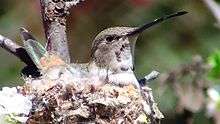Oasis hummingbird
| Oasis hummingbird | |
|---|---|
 | |
| Scientific classification | |
| Kingdom: | Animalia |
| Phylum: | Chordata |
| Class: | Aves |
| Order: | Apodiformes |
| Family: | Trochilidae |
| Genus: | Rhodopis L. Reichenbach, 1854 |
| Species: | R. vesper |
| Binomial name | |
| Rhodopis vesper Lesson, 1829 | |
 | |
| In green, The distribution of this species. | |
The oasis hummingbird (Rhodopis vesper) is a species of hummingbird in the family Trochilidae. It is found in coastal regions of Peru in a 100–200 km wide strip that extends the length of Peru's coastline, about 3000 km. It is also found in an adjacent population in Chile; a second disjunct population in coastal Chile exists 2000 km to the south, in a 75 by 200 km coastal strip.
The oasis hummingbird's natural habitats are subtropical or tropical dry shrubland, subtropical or tropical moist shrubland, and subtropical or tropical high-altitude shrubland.
Description
The Oasis hummingbird is a mid-sized hummingbird with an average length of 13-13.5 cm for an adult male and 11-11.5 cm for an adult female. They have an olive green colored back and grey to white colored breast with a distinctive cinnamon colored rump. They have a long, decurved, black bill. They are sexually dimorphic with males having a brightly iridescent gorget that is blue to red in color and a long forked tail. Females have much shorter tail feathers and no iridescent gorget.[2]
Habitat, range and migration
The hummingbird can inhabit a variety of niches from desert oases, urban areas, arid scrub lands and dry coastal deserts. They are endemic to south America and restricted to the Pacific coast of Peru and Chile, though evidence suggests they are expanding south. Populations in the northern and southernmost reaches of their range have smaller individuals than in the central regions, the reason for this being currently unknown. There are no known migration patterns and it is thought that they are fairly sedentary, however colonization events at newly emergent oases would indicate that they occasionally venture out to explore new regions.[3]
Behavior And Diet
They live solitary lives as adults and are very territorial. Males do not tolerate other males within their territory, though they seem to be more accepting of males of different species. During the breeding period, the males occupy a home range of about 40x 40 meters. Their diet is understudied at the moment but the morphology of their bill is evidence that they, like most hummingbirds, feed primarily on nectar as a source of energy. They are known to eat small invertebrates as well.[4][5]
Courtship
The males perform various courtship displays in order to attract mates. They have what is called a shuttle display where they hover about 10–15 cm in front of a female, sing, flare their bright gorget and move up, down, left and right in an attempt to impress the potential mate. They spread their tail feathers while doing this and wave them side to side. During normal flight, they beat their wings constantly at a fairly regular frequency. High speed video has shown that while performing their shuttle display, the males actually stop fluttering for just a fraction of a second to tuck their wings away causing them to descend slightly before recommencing their wing beating. This makes them appear to bound in place. They also have a dive display where they will soar into the air and swoop down by the females while making a sharp whistling sound with their tail feathers.[6]
Reproduction
As of now, little is known about the life cycle of the Oasis Hummingbird. Like most hummingbirds, the female is solely responsible for the incubation and rearing of the young while the male leaves immediately after copulation. The incubation period is about 16 days and the nestling period about 27. The average clutch size is 2 eggs and the dimensions of an egg are 13.8x9.2 mm.[7]
References
- ↑ BirdLife International (2012). "Rhodopis vesper". IUCN Red List of Threatened Species. Version 2013.2. International Union for Conservation of Nature. Retrieved 26 November 2013.
- ↑ Schulenberg, T S & Jaramillo, A. Rhodopis vesper. The Cornell Lab of Ornithology. http://neotropical.birds.cornell.edu/portal/species/overview?p_p_spp=276216 access date 14 October 2015
- ↑ Schulenberg, T S & Jaramillo, A. Rhodopis vesper. The Cornell Lab of Ornithology. http://neotropical.birds.cornell.edu/portal/species/overview?p_p_spp=276216 access date 14 October 2015
- ↑ Schulenberg, T S & Jaramillo, A. Rhodopis vesper. The Cornell Lab of Ornithology. http://neotropical.birds.cornell.edu/portal/species/overview?p_p_spp=276216 access date 14 October 2015
- ↑ Clark, C J, Feo T J, van Dongen, W F D. SOunds and courtship displays of the Peruvian Sheartail, Chilean Woodstart, Oasis Hummingbird, and a hybrid male Peruvian Sheartail x Chilean Woodstart. The Condor. 115(3): 558-575
- ↑ Clark, C J, Feo T J, van Dongen, W F D. SOunds and courtship displays of the Peruvian Sheartail, Chilean Woodstart, Oasis Hummingbird, and a hybrid male Peruvian Sheartail x Chilean Woodstart. The Condor. 115(3): 558-575
- ↑ Schulenberg, T S & Jaramillo, A. Rhodopis vesper. The Cornell Lab of Ornithology. http://neotropical.birds.cornell.edu/portal/species/overview?p_p_spp=276216 access date 14 October 2015
External links
- Oasis hummingbird videos on the Internet Bird Collection
- Oasis hummingbird photo gallery VIREO Photo-High Res
- Photo; Article focusonnature (Article-no.2)
- Photo--Very High Res; Article pbase.com—"Our favorite photos"
